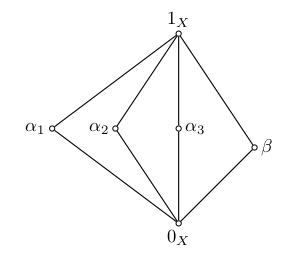
Suppose the lattice shown below is a congruence lattice of an algebra.

Conjecture: If the three $\alpha_i$'s pairwise permute, then all pairs in the lattice permute.
Whether or not this claim is true is a simplified version of a question left open by Pálfy and Saxl at the end of their 1990 paper. Below is a more formal statement of the problem, and a link to my notes describing a proposed method of solution. There remains one gap in the proof, that I'm not yet sure how to fill, but I am hopeful that the overall strategy will work.
🔗 Graphical composition
In an attempt to prove the claim above and its generalization, I apply an idea described in Heinrich Werner's paper called graphical composition.
🔗 The Problem
Before giving a more precise statement of the problem, let us recall a couple of basic definitions. Given two equivalence relations $\alpha$ and $\beta$ on a set $X$, the relation
$$\alpha \circ \beta = {(x,y) \in X^2: (\exists z)(x ; \alpha ; z ; \beta ; y)}$$
is called the composition of $\alpha$ and $\beta$, and if $\alpha \circ \beta = \beta \circ \alpha$ then $\alpha$ and $\beta$ are said to permute.
Problem. $\def\bA{\bf A} \def\bB{\bf B}$ Let $\bA$ be a finite algebra with $\operatorname{Con} \bA$ isomorphic to $M_n$, for some $n\geq 4$. If three nontrivial congruences of $\bA$ pairwise permute, does it follow that every pair of congruences of $\bA$ permute?
🔗 GitHub repository
My GitHub repository contains the following:
 follow me on github
follow me on github Curriculum Vitæ
Curriculum Vitæ


